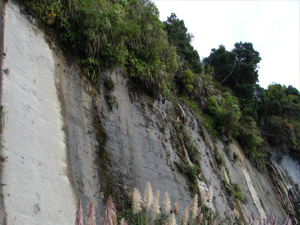Brachyglottis turneri - a giant cliff dwelling daisy
Scientific name: Brachyglottis turneri (Brachyglottis from the Greek meaning ‘short tongue’ which refers to the short ray florets of the inflorescence and turneri after E.P. Turner, 1865-1937.)
Family name: Asteraceae (Daisy Family)
Brachyglottis turneri is a rare cliff dwelling daisy distinguished by its large, widely curved and pointed leaves, long leaf stalks, and clusters of bright yellow daisy like flowers in summer. It is generally found growing on the crests or faces of wet cliffs (with seepages) or overhanging streams and rivers. It has been recorded in several isolated localities in Taranaki including the upper Wanganui River, mid Mokau River, the middle reaches of the Waitara River, and in the Tangarakau and Mimi Scenic Reserves of North Taranaki.
Perhaps the most easily accessed locality in which to see these unique cliff dwellers is on the wetter portions of papa cliffs about half way along and on the eastern (inland) side of the Mimi Road (‘Old Stock Route’), which is opposite to where Mangamaio Road joins State Highway 3. The plants are clearly visible from the road, and some can be found growing quite low down, but generally binoculars are recommended for a closer look. They are seen mainly mixed in with the drooping flat green strap like foliage of the sedge Machaerina sinclairii (tuhara) on the upper part of the cliff.
Brachyglottis turneri is named after Edward Phillips Turner, forester and co-author with L. Cockayne of Trees of New Zealand (1928), who was active in Taranaki as Inspector of Scenic Reserves in the early 1900s. He was also the first Secretary of Forestry and was the Director of Forestry from 1928 to 1931.
Although this remarkable plant is rarely seen the habitat in which it generally grows is widely dispersed and remote and has not been thoroughly explored. It is recorded on the official 2009 Threatened and Uncommon Plants of New Zealand list as Naturally Uncommon because of its confinement to and dependence on the specific habitat described.
Photos

Brachyglottis turneri flowers and foliage

Brachyglottis turneri cliff face habitat
Plant List